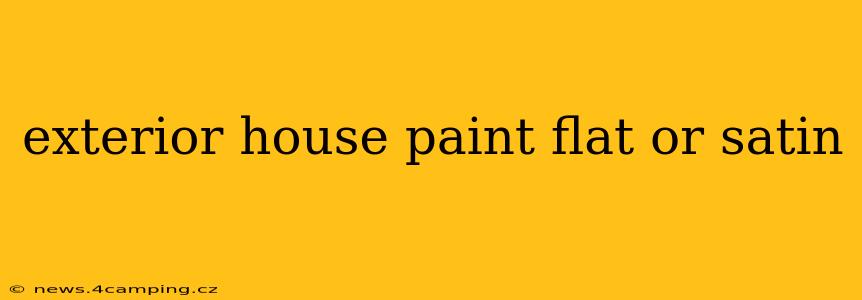Choosing the right exterior house paint finish is crucial for both aesthetics and longevity. Two popular choices are flat and satin, each offering distinct advantages and disadvantages. This comprehensive guide will help you decide which finish best suits your home and its unique needs. We'll explore the key differences, considering factors like durability, cleaning, and overall appearance to help you make an informed decision.
What is Flat Exterior Paint?
Flat paint, also known as matte paint, has a completely non-reflective finish. This means it absorbs light, minimizing the appearance of imperfections on the surface of your home's exterior. This can be a significant advantage for older homes with textured surfaces or minor imperfections. However, this lack of sheen also makes it less durable and more difficult to clean.
Advantages of Flat Exterior Paint:
- Hides imperfections: Excellent at masking minor flaws in the wall surface.
- Elegant, classic look: Provides a sophisticated, understated finish.
- Often more affordable: Generally less expensive than higher-sheen options.
Disadvantages of Flat Exterior Paint:
- Low durability: More susceptible to scuffs, scratches, and general wear and tear.
- Difficult to clean: Spills and dirt are harder to remove; cleaning often requires gentle scrubbing, which can damage the paint over time.
- Less mildew resistant: The porous nature of flat paint makes it more prone to mildew growth, especially in humid climates.
What is Satin Exterior Paint?
Satin paint offers a low-sheen finish, somewhere between flat and semi-gloss. It possesses a subtle, elegant sheen that provides a more durable and easily cleaned surface compared to flat paint. The slight sheen helps to reflect light, making it a versatile choice for many homes.
Advantages of Satin Exterior Paint:
- More durable than flat: Resists scuffs and scratches better than flat paint.
- Easy to clean: Dirt and grime can be easily wiped away, prolonging the life of the paint.
- Better mildew resistance: The smoother surface is less susceptible to mildew growth.
- Good for high-traffic areas: Ideal for areas prone to frequent contact or accidental damage.
Disadvantages of Satin Exterior Paint:
- Shows imperfections more readily: The slight sheen can highlight minor imperfections on the wall surface.
- Slightly more expensive: Typically costs a bit more than flat paint.
Which Finish is Better for My Home's Exterior?
The best choice depends on several factors:
- Your home's condition: If your home has significant imperfections, flat paint might be a better option to mask them. However, if your home is in good condition, the durability and cleanability of satin paint are attractive benefits.
- Your climate: In humid or rainy climates, satin paint's better mildew resistance is advantageous.
- Your lifestyle: If you have children or pets, or live in a high-traffic area, satin's durability is a practical choice.
- Your budget: Flat paint is typically less expensive, while satin paint offers increased longevity and easier maintenance.
How Long Does Exterior Paint Last?
The longevity of exterior paint depends on several factors including the quality of the paint, the paint's finish (satin generally lasts longer than flat), the climate, and the preparation of the surface before painting. Generally, you can expect high-quality exterior paint to last anywhere from 5 to 10 years, sometimes even longer with proper maintenance.
What is the Best Exterior Paint for a House?
There is no single "best" exterior paint for every house. The optimal choice depends on your individual needs and preferences, as discussed above. Consider the factors outlined in this guide to make an informed decision. Always choose a high-quality paint from a reputable brand for optimal results.
Can I Use Interior Paint on the Exterior of My House?
No, you should never use interior paint on the exterior of your house. Interior paints lack the necessary UV protection and durability to withstand the elements. Using interior paint on the exterior will lead to premature fading, peeling, and deterioration, resulting in costly repainting sooner than expected.
By carefully considering these factors and the differences between flat and satin exterior paints, you can choose the best option for your home, ensuring a beautiful and long-lasting finish. Remember to always prepare your surfaces properly before painting for the best possible results.
